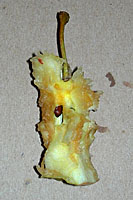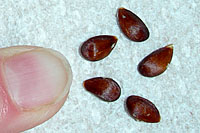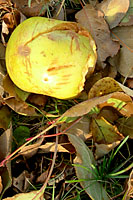Terry L. Ettinger Horticulture Consulting Services
Meeting The Needs Of Today With A Vision For The Future
Question of the Week
Growing Apple Trees From Seed
 Q. I've saved some seed from what I think were `Yellow Transparent' apples that I collected from an old tree last fall. I cleaned the seed and have kept them in a cool room. Now I want to know how to get them to
germinate. This was my favorite apple as a child more than fifty years ago, and I would love to get one started in our
backyard before I get much older.
Q. I've saved some seed from what I think were `Yellow Transparent' apples that I collected from an old tree last fall. I cleaned the seed and have kept them in a cool room. Now I want to know how to get them to
germinate. This was my favorite apple as a child more than fifty years ago, and I would love to get one started in our
backyard before I get much older.
A. I have both good news and bad to share with you. The bad news is that apples are generally cross-pollinated.
What this means is that bees visiting the flowers of the tree from which you collected fruit could've delivered pollen from hundreds of different edible and crab apples in your neighborhood. Therefore, in theory, each of the seeds in the apples you collected could result in a tree bearing slightly different kinds of apples - none of which are true `Yellow Transparent.'
 (As an aside, the only difference between
an "edible" apple, at left in the picture at left, and
"crab" apples, at right in the picture at left, is that the fruit of crabapples, which tend to be
quite sour, are less than two inches in diameter. Also, an apple
will almost always contain between five and ten seeds.)
(As an aside, the only difference between
an "edible" apple, at left in the picture at left, and
"crab" apples, at right in the picture at left, is that the fruit of crabapples, which tend to be
quite sour, are less than two inches in diameter. Also, an apple
will almost always contain between five and ten seeds.)
If you're still interested in sowing the seed you've collected, even though the chances of getting a tree identical to the one you want to save are pretty slim, the process is relatively easy.
 The first step is to rinse the seed you collect with a spray of cold water, then dry them on paper towels for a day or two.
The first step is to rinse the seed you collect with a spray of cold water, then dry them on paper towels for a day or two.
Next, mix the seed with moist, but not sopping wet, peatmoss or peatmoss-based potting soil (e.g., Pro-Mix, Jiffy-Mix, etc.), then place the mixture into ziplock bags, label the bags with the date, and set them on a shelf in your refrigerator for three months.
Exposing the apple seeds to three months of moist, cold
conditions is called "vernalization." During this time, the hard covering (the seed "coat") softens and naturally occurring
chemicals that prevent the embryo inside the seed from germinating are gradually
 broken down.
Essentially, this process attempts to duplicate the conditions the
seed would be exposed to if it where enclosed in an apple that was
eaten by an animal in the fall, then spent the winter on the ground
in a decaying pile of . . . . . . , well, you know.
broken down.
Essentially, this process attempts to duplicate the conditions the
seed would be exposed to if it where enclosed in an apple that was
eaten by an animal in the fall, then spent the winter on the ground
in a decaying pile of . . . . . . , well, you know.
At the end of three months, sow the seed/potting soil mixture about one half-inch deep over a layer of potting soil in a 6" diameter pot, then place it in a very bright, warm location. Or, if you stored the seed in January or February, you can sow the mixture directly in a sunny spot in your garden in April and cover the seed with a piece of chicken wire.
Keep the seed mixture moist at all times, and in six to eight weeks you should see at least a few seedlings beginning to grow. At the end of the first growing season, transplant surviving seedlings two feet apart into a spot in your garden that you can protect from hungry deer, rabbits and/or other critters.
If your successful at keeping these seedlings alive (maybe ultimately only five or ten from an original hundred seed collected from fifty apples), they should be about four feet tall and ready to transplant to their permanent location at the beginning of their fourth year. They should flower by the time they're six or seven years old, and bear fruit be the time they're ten years old
Now, if this sounds like more work than it's worth, the good news is that there are a number of nurseries throughout the country that specialize "old" apple tree varieties. Contact information and links to many of these nurseries can be found on the North American Fruit Explorers "Nursery/Supplies Source List."
And, if you're especially interested in learning more about the origins of the apple, click here to go to the U.S.D.A. Plant Genetic Resources Unit website. This facility is home to the world's largest collection of cultivated and wild apple varieties and is located less than an hour from Syracuse in Geneva, New York!
By the way, `Yellow Transparent' was introduced from Russia in the 1870's and was a very important, very early ripening apple in commercial orchards up until about World War II. A modern variety with similar traits is `Lodi.'